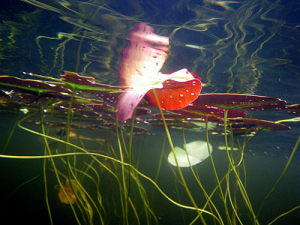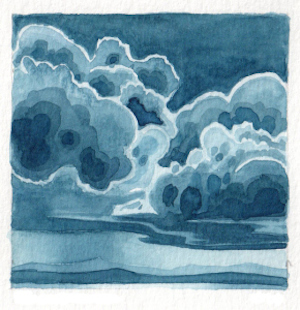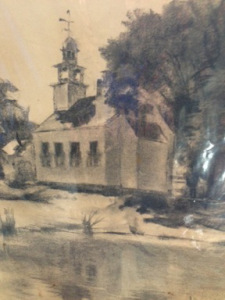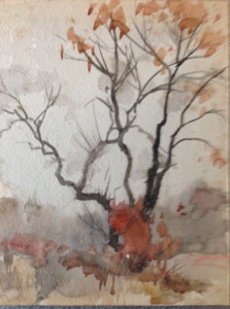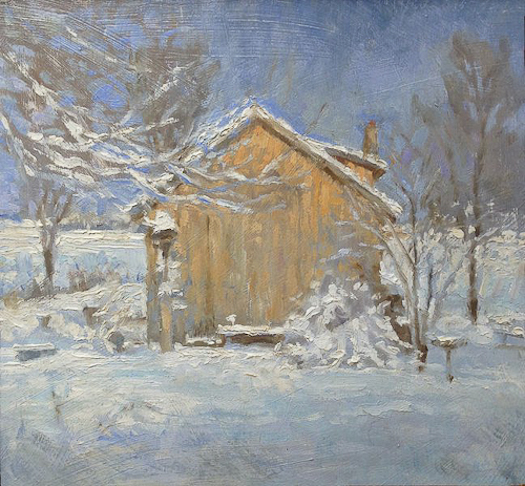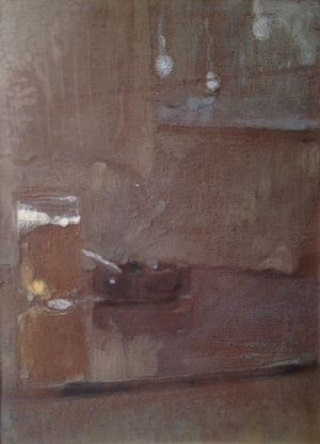
Call housekeeping
"Earth's Household'' (watercolor and graphite on paper), by Emile Clark, at the Patricia Ladd Carega Gallery, Center Sandwich, N.H.
On 'Golden Pond'
"Squam Series: Side Porch" (oil on canvas), by Frances Hamilton, at the Patricia Ladd Carega Gallery, Center Sandwich, N.H.
Overlooking Squam Lake.
Beautiful Squam Lake, long a much-loved summer vacation spot, is in the Lakes Region of central New Hampshire and just northwest of much larger Lake Winnipesaukee.
Native Americans called Squam Keeseenunknipee, which meant "the goose lake in the highlands". The white settlers that followed shortened it to "Casumpa," "Kusumpy" and/or "Kesumpe" around 1780. In the early 19th Century, the lake was given another Abenaki name, Asquam, which means "water". Finally, in the early 20th Century, Asquam was shortened to its present version.
The 1981 film On Golden Pond, with Jane Fonda, her father, Henry Fonda, and Katherine Hepburn, was filmed in Center Harbor, on Squam. Two tour-boat services are available on the lake, both based in Holderness (where there’s a prep school of the same name) -- Experience Squam, a private charter company, and the Squam Lakes Natural Science Center. Both show movie locations and items of natural and other significance.
Loons, eagles and great blue herons frequent Squam Lake.
Literature for the ages
"Charlotte's Web'' (crystallized book), by Georgia Heard, at Patricia Ladd Carega Gallery, Center Sandwich, N.H.
Shorthand for let's talk
"Covers and Conversation'' (mixed media/collage), by C.C. White, at the Patricia Ladd Carega Gallery, Center Sandwich, N.H.
Best month for sunny spots
"There is no season when such pleasant and sunny spots may be lighted on, and produce so pleasant an effect on the feelings, as now in October."
-- Nathaniel Hawthorne
New Hampshire blue
"Canoers'' (oil on canvas), by Kim Case, at the Patricia Ladd Carega Gallery, Center Sandwich, N.H.
New England's ancient dairy delirium
"Milk Made'' (mixed media), by Peter Thibeault, at Patricia Ladd Carega Gallery, Center Sandwich, N.H.
Welcome to the allergy room
"Fritz's Barn'' (oil on canvas), by Tom Pirozzoli, at the Patricia Ladd Carega Gallery, Center Sandwich, N.H.
It always is
"Storm Season'' (watercolor), by Brian Herrick, at Patricia Ladd Carega Gallery, Center Sandwich, N.H.
Her Iceland and mine
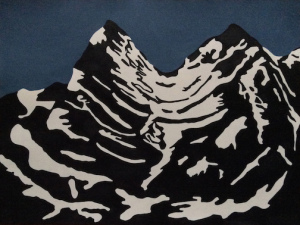 From the "My Iceland'' show, by LAURA MARCONI, at the Patricia Ladd Carega Gallery, Center Sandwich, N.H.
From the "My Iceland'' show, by LAURA MARCONI, at the Patricia Ladd Carega Gallery, Center Sandwich, N.H.
I remember the bizarre beauty of Iceland from a stopover I made there in 1974 via Icelandic Airlines, which offered the cheapest flights to Europe.
The catches were that you had to stop in Iceland and (the Icelanders hoped) buy something there and that the flights to Europe all terminated in Luxembourg, a charming duchy but from which you had to get to where you really wanted to go, such as Paris.
-- Robert Whitcomb
Sheets to the wind
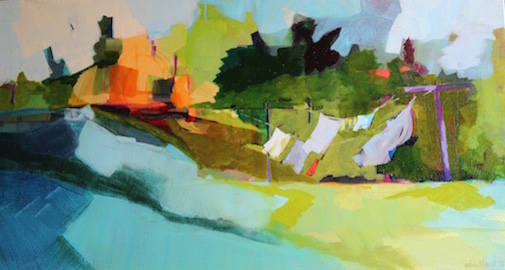 "Revisiting Atticus' Laundry'' (oil on canvas), by ASHLEY BULLARD, at the Patricia Ladd Carega Gallery, Center Sandwich, N.H.
"Revisiting Atticus' Laundry'' (oil on canvas), by ASHLEY BULLARD, at the Patricia Ladd Carega Gallery, Center Sandwich, N.H.
When I was a kid we had an area for hanging laundry outdoors that was enclosed by high wooden fences, since public display of laundry was considered in bad taste. Driers weren't very efficient then, so the usual practice was to hang laundry outdoors on sunny days. This was a long time ago, when refrigerators were still often called ice boxes.
But now, letting laundry dry in the wind evokes praise for the energy-consciousness it suggests.
-- Robert Whitcomb
Now for those New Year's cards
"Winter Studio'' (oil on masonite), by MICHAEL DOYLE, at Patricia Ladd Carega Gallery, Center Sandwich, N.H.
This is the time of year, right after Christmas, when many of us feel compelled to try to put the past year in perspective and to mull how we can pave the road for the next one, clearing out the trivial as much as possible. It's time for the big picture. And yet the trivial -- thank-you notes, year-end financial accounts, holiday meals, etc. -- get in the way even as a clear, cold morning puts us in the mood for finding clarity and throwing out excess baggage, which doesn't stop piling up.
Now I have to get back to writing notes on those ''Happy New Year'' cards we send out because we got too far behind to send Christmas cards.
-- Robert Whitcomb
Their 2 major food groups: Nicotine and alcohol
''Beer and Cigarette'' (oil on plexy), by MICHAEL DOYLE, at Patricia Ladd Carega Gallery, in Center Sandwich, N.H.
It wasn't that long ago that millions of workers daily repaired after their shifts to smoky joints like the one that this picture recalls. These places were very close to offices or factories. Indeed, the bars were often scientifically located specifically to serve this or that local big company.
Employees could chain-smoke simply by breathing in the air of the bar. For hours, they'd drink and do supplemental smoking. Then, especially if it were late in the week, repeat the process all over again the next day. Now folks can't smoke in bars, which reduces the desire for drink, which reduces the desire to smoke. (The big exception: The giant bars known as casinos, where state taxing authorities, and income-and-sales-tax-hating citizens, want the cross-promotional addictions of booze, cigarettes and gambling to keep pumping up state budgets from states' draw on casino revenues.)
For that matter, plenty of people went to bars on their "lunch break,'' and unless they were falling down drunk when they returned to the offices or factory, it was tolerated -- indeed, expected. Executives did it, too, albeit more likely ordering cocktails and bottles of wine than what their lackeys bought, which was mostly (bad) beer.
About half the news desk staff at the old Boston Herald Traveler, where I worked, would go next door to a joint called Foley's and toss back a few at their "lunch,'' which came at mid-evening. (It was a morning paper so the paper was mostly produced between about 6 p.m. and 2 a.m.).
The daily heavy-drinking habit, along with relentless deadlines, rapidly aged the editors. Many of those who I thought were around 60 were in fact about 40. But many were addicted to the daily adrenaline of deadines and breaking news (much of which was suffused with false urgency).
All in all, a lousy way to live, but we all got stories about at least mild depravity out of it. Some of us even still remember them.
--- Robert Whitcomb
















